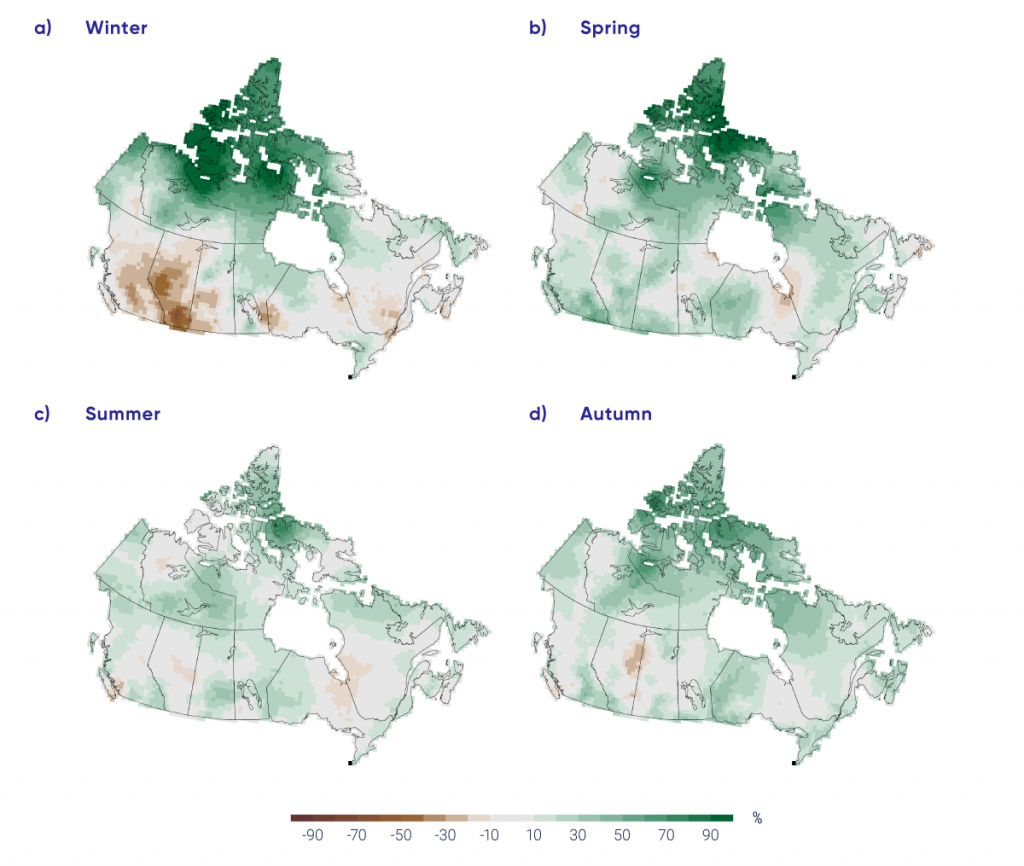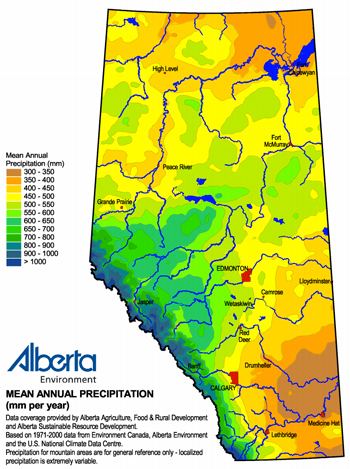Climate in Alberta
Alberta, as the fourth largest province in Canada, has a land area of 640,330 square kilometers [i]. It is located between 49°N to 60°N and 110°E to 120°E [ii]. The elevation varies from 170 metres (above sea level) in the Wood Buffalo National Park in the northeast to as high as 3,747 metres (above sea level) in the Rocky Mountains along the southwestern border. This variation, as well as the variation in sea surface temperature of the Pacific Ocean, has a pronounced influence on the diversity of the climate.
For example, in the south-east region of Alberta, annual precipitation has ranged from a high of 689 mm in 1927, the highest year on record, to 186 mm in 2001, the driest year on record. The flow of the South Saskatchewan River reflects that variability. No other place in Canada, and few others on earth, have this much variability in both climate and annual water balance.
Temperature
Although most parts of Alberta could be classified as semi-arid, its climate varies considerably. Daily mean temperatures range in January from −8°C in the south to −24°C in the north, and in July from 24°C in the south to 16°C in the north.
Arctic air masses in the winter can produce extreme minimum temperatures, varying from -54°C in northern Alberta to -46°C in southern Alberta. However, in the summer, continental air masses produce maximum temperatures ranging from 32°C in the mountains to over 40°C in southern Alberta.
Caution
Note that the above information is changing as a result of climate change. We have tried to find newer equivalent maps of temperature means for the period since 2000 but have not succeeded. However, we know that climate change has measurably increased average annual temperatures over the 1900-2016 time period. This warming is not the same across Alberta and Canada: on average the northern areas are warming more than the southern areas. Also, there is seasonal variation in the magnitude of the changes: in the Prairies, there has been an annual increase of 1.9°C (1948-2016) but in the Winter the average annual increase has been 3.1°C [iii]. As the temperature increases, evaporation is expected to increase with significant implications for soil moistures conditions during the growing season.
Precipitation
Annual precipitation ranges from less than 350 mm/year in the southeast to over 450 mm/year in the northwest, except in the foothills of the Rocky Mountains, where rainfall can exceed 600 mm/year. It should be noted that precipitation in any month can be extremely variable with the variability of precipitation being greater in southern Alberta than in the Peace River Region and central Alberta [iv] (p.6-7).
The south and east-central portions are prone to drought-like conditions, sometimes persisting for several years, although even these areas can receive heavy precipitation.
Caution

Note that the information presented above is based on data collected from 1971-2000. However, the climate in Alberta is changing. As per a 2019 report, Alberta’s Climate Future [v], little change is expected in Alberta’s average annual precipitation. However, the timing and nature of that precipitation is expected to change with more precipitation arriving in the form of rain and earlier in the year. See Figure 3 for observed changes across Canada for the period 1948-2021.
For more information, visit the Alberta Climate Information Service for over 10,000 current maps of Alberta weather and climate information.
Sources:
[i] Statistics Canada, 2019, Focus on Geography Series, 2016 Census: Province of Alberta. https://www12.statcan.gc.ca/census-recensement/2016/as-sa/fogs-spg/Facts-pr-eng.cfm?LANG=Eng&GK=PR&GC=48&TOPIC=1. Accessed 2023-08-02.
[ii] Britannica, 2023, Alberta. https://www.britannica.com/place/Alberta-province. Accessed 2023-08-02.
[iii] Government of Canada, 2019, Canada’s Changing Climate Report. https://changingclimate.ca/CCCR2019/chapter/4-0/. Accessed 2023-07-26.
[iv] Alberta Agriculture, Food and Rural Development, 2005, Agricultural Land Resource Atlas of Alberta, 2nd Edition. https://open.alberta.ca/publications/agricultural-land-resource-atlas-of-alberta-2nd-edition. Accessed 2023-07-26.
[v] Hayhoe, K. & Stoner, A., 2019, Alberta’s Climate Future. https://open.alberta.ca/publications/albertas-climate-future-final-report-2019. Accessed 2023-07-26.


